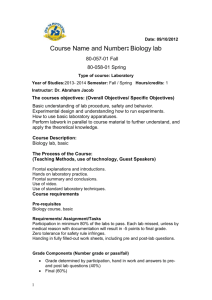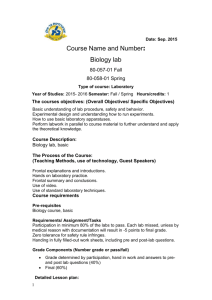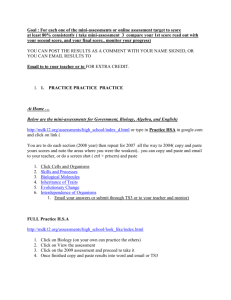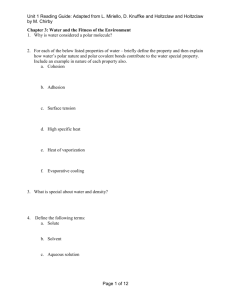LAB 1 – Diffusion and Osmosis 1. Find your “WATER WILL MOVE
advertisement
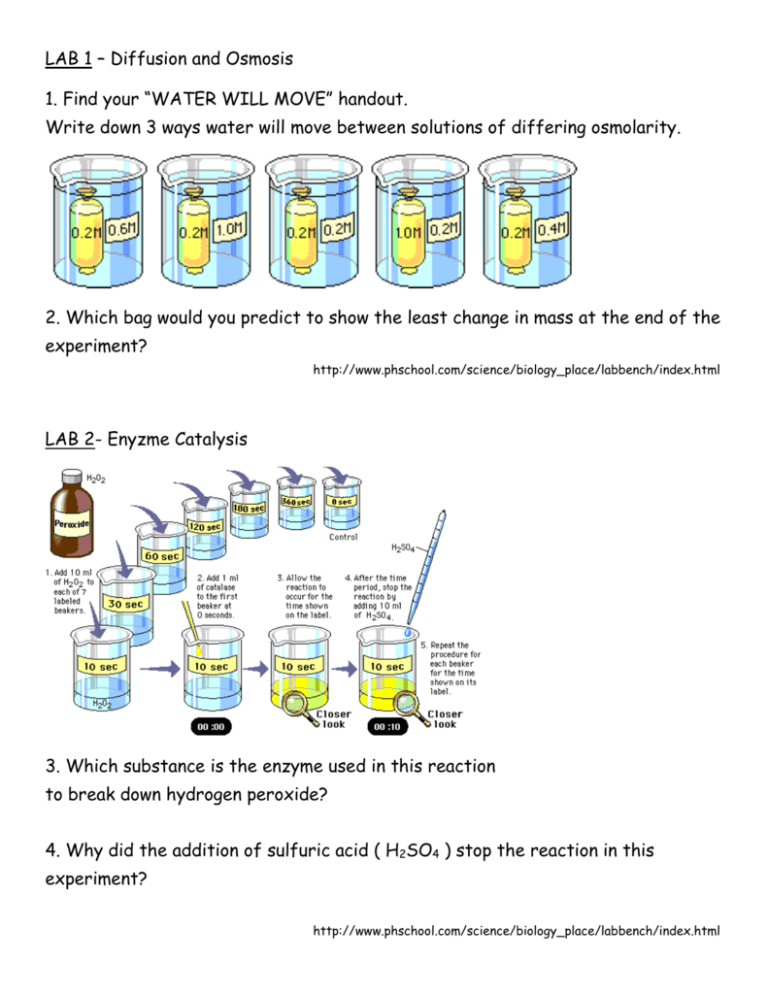
LAB 1 – Diffusion and Osmosis 1. Find your “WATER WILL MOVE” handout. Write down 3 ways water will move between solutions of differing osmolarity. 2. Which bag would you predict to show the least change in mass at the end of the experiment? http://www.phschool.com/science/biology_place/labbench/index.html LAB 2- Enyzme Catalysis 3. Which substance is the enzyme used in this reaction to break down hydrogen peroxide? 4. Why did the addition of sulfuric acid ( H2SO4 ) stop the reaction in this experiment? http://www.phschool.com/science/biology_place/labbench/index.html LAB 3- Mitosis and Meiosis 5. Which of the following statements is correct? A) Crossing over occurs in prophase I of meiosis and metaphase of mitosis. B) DNA replication occurs once prior to mitosis and twice prior to meiosis. C) Both mitosis and meiosis result in daughter cells identical to the parent cells. D) Karyokinesis occurs once in mitosis and twice in meiosis E) Synapsis occurs in prophase of mitosis. From: Holtzclaw and Holtzclaw AP Biology Test Prep Series 6. Which phase of mitosis is called “reverse prophase”? LAB 4- Plant pigments and Photosynthesis 7. What is the Rf value for carotene calculated from the chromatogram shown? A) 1.09 B) 0.17 C) 0.96 D) 0.33 E) 0.50 From: Holtzclaw and Holtzclaw AP Biology Test Prep Series LAB 4 8. What is the role of DPIP in Experiment #4 A) It mimics the action of chlorophyll by absorbing light energy B) It serves as an electron donor and blocks the formation of NADPH C) It is an electron acceptor and is reduced by electrons from chlorophyll. D) It is bleached in the presence of light and can be used to measure light levels. Image modified from: Holtzclaw and Holtzclaw AP Biology Test Prep Series LAB 5- Cell Respiration 9. What is the rate of oxygen consumption in germinating corn at 12° C as shown in the graph below? A) 0.08 ml/min B) 0.04 ml/min C) 0.8 ml/min D) 0.6 ml/min E) 1.00 ml/min 10. What was the role of the KOH placed on the cotton ball in the end of the vial? A) It serves as an electron donor to promote cellular respiration B) As KOH breaks down, the oxygen needed for cellular respiration is released C) It serves as a temporary energy source for the respiring pea seed D) It binds with CO2 to form a solid, preventing CO2 production from affecting gas volume in the vial E) Its attraction for water will cause water to enter the respirometer From: Holtzclaw and Holtzclaw AP Biology Test Prep Series LAB 6- Molecular Biology In a lab students obtained competent E. Coli cells and used a common transformation procedure to induce the uptake of plasmid DNA with a gene for resistance to the antibiotic kanaycin. The results obtained are shown. 11. On which petri dish do only transformed cells grow? I II III IV From: Holtzclaw and Holtzclaw AP Biology Test Prep Series LAB 6 12. The plasmid shown has restriction sites for BAMHI and EcoRI restriction enzymes as shown. Several digests were prepared using these two enzymes either alone or in combination. Use the figures to answer the following question. (Hint: Begin by determining the number and size of the fragments that would be produced. “kb” stands for kilobases or thousands of base pairs) Which lane shows a digest with BamHI only? I II III IV V From: Holtzclaw and Holtzclaw AP Biology Test Prep Series LAB 7-Genetics of Organisms http://www.phschool.com/science/biology_place/labbench/index.htm 13. 1. On the basis of the results shown in the table, which statement is most likely true? A) The genes for red eyes and normal wings are linked B) The gene for no wings is sex-linked C) The gene for red eyes and the gene for no wings are both dominant D) The gene for eye color is inherited independently of the gene for wings E) The F1 mates were both homozygous for both eye color and wings. http://www.phschool.com/science/biology_place/labbench/index.html 14. Chi square calculations result in X2 = 5.14 If the experiment has 1 degree of freedom, would you accept or reject the hypothesis that these data are not statistically different from the expected? http://www.phschool.com/science/biology_place/labbench/index.html LAB 8- Population Genetics and Evolution 15. Phenylketonuria (PKU) is a human metabolic disorder that results in mental retardation if it is untreated in infancy. In the United States, one out of approximately 10,000 babies is born with the disorder. Approximately what percent of the population are heterozygous carriers of the recessive PKU allele? 16. Which of the following is NOT a condition that must be met for HardyWeinberg equilibrium? A) large population B) no mutation C) no immigration or emigration D) dominant alleles more frequent than recessive alleles E) no natural selection http://www.phschool.com/science/biology_place/labbench/index.html Lab 9- Transpiration 17. Which type of environment would result in the greatest rate of transpiration? A) cloudy, humid conditions B) warm, humid conditions C) warm, light-breezy conditions D) cool, humid conditions 18. Under conditions of bright light, in which part of a transpiring plant would water potential be the lowest? A) xylem vessels in the leaves B) xylem vessels in the roots C) root hairs D) spongy mesophyll of the leaves From: Holtzclaw and Holtzclaw AP Biology Test Prep Series Lab 10- Physiology of Circulatory System 19. What effect does temperature have on the heart rate in daphnia? 20. Which of the following organisms would show the greatest fluctuation in body temperature hour by hour? A) dolphin B) mouse C) lake trout D) rattlesnake E) human From: Holtzclaw and Holtzclaw AP Biology Test Prep Series Lab 11-Animal Behavior 21. How is taxis different from kinesis? 22. Students placed five pillbugs on the dry side of a choice chamber and five pillbugs on the wet side. They collected data as to the number on each side every 30 seconds for 10 minutes. After 6 minutes, eight or nine pillbugs were continually on the wet side of the chamber, and several were under the filter paper. Which of the following is NOT a reasonable conclusion from these results? A) It takes the pillbugs several minutes to explore their surroundings and select a preferred habitat B) Pillbugs prefer a moist environment. C) Pillbugs prefer a dark environment D) Pillbugs may find chemicals in dry filter paper irritating. E) Pillbugs demonstrate no significant habitat preference. http://www.phschool.com/science/biology_place/labbench/index.html LAB 12- Dissolved oxygen and Aquatic Primary Productivity 23. Why were the bottles placed in screened bags in Lab 12? 24. Many lakes in South Dakota turn green due to agricultural runoff over the summer. How would the net productivity in the water at the bottom of these lakes change from the beginning to the end of the summer ?
